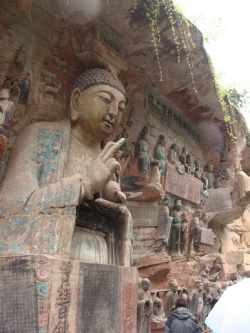The Dharma
The Buddha taught the Dharma solely out of compassion for sentient beings who suffer in the cycle of birth and death. The Dharma is therefore taught without any selfish motives. It is well-taught and completely good. It is by nature pure and bright like a light that destroys the darkness of ignorance. When the Dharma is studied and practised, it brings many benefits now and in the future.
The Dharma is the Teaching about the nature of life. This Teaching of the Buddha is contained in the three collections of scriptures called the Tripitaka or the "Three Baskets". These consist of the sermons (Sutra Pitaka) said to have been taught by the Buddha, the rules governing the discipline of the monastic community (Vinaya Pitaka) and the philosophy and psychology of Buddhism (Abhidharma Pitaka).
A Buddhist gets to know about the Dharma by reading the scriptures. He also learns from the writings and explanations of qualified teachers of Buddhism. Once he has familiarised himself with the Dharma through reading and listening, he has to realize the truth for himself by putting it into practice. This means purifying his conduct and cultivating Mental Development until the Teaching becomes part of his own experience.
Do not accept any of my words on faith,
Believing them just because I said them.
Be like an analyst buying gold, who cuts, burns,
And critically examines his product for authenticity.
Only accept what passes the test
By proving useful and beneficial in your life.
The Buddha (Jnanasara-samuccaya)
INTRODUCTION
Dharma is a Sanskrit word with many meanings, but in this case, we will mainly use it in the meaning of the "Buddha-dharma" or the teachings of the Buddha. Probably the shortest summary the Buddha himself gave of his teachings is
"I teach on suffering and the way to end it".
Shakyamuni Buddha, the historical teacher gave many teachings during his life, and it is not very simple to condense these all into a small, comprehensive package. Moreover, during the last 2,500 years, various different traditions have developed in Buddhism (see history), which all are based on slightly different interpretations of his teachings, and emphasize somewhat different practices.
The Buddha gave some remarkably modern-sounding advice just before his passing away on how to approach the teachings, called the Four Reliances:
"Rely on the teaching, not on the person;
Rely on the meaning, not on the words;
Rely on the definitive meaning, not on the provisional;
Rely on your wisdom mind, not on your ordinary mind."
These kind of statements may clarify a bit why there is not simply 'one Buddhism'; every individual is encouraged to use their own intellect and wisdom to figure out what the teachings mean for them.
Buddha-dharma is also not a simple, easy-to-grasp subject, as the Buddha himself explained:
"This Dhamma that I have attained is profound, hard to see and hard to understand, peaceful and sublime, unattainable by mere reasoning, subtle, to be experienced by the wise."
WHAT IS BUDDHISM?
This question is easier asked than answered. Lama Anagorika Govinda expressed it as follows in 'Living Buddhism for the West':
"Thus we could say that the Buddha's Dharma is, as experience and as a way to practical realization, a religion; as the intellectual formulation of this experience, a philosophy; and as a result of self-observation and analysis, a psychology. Whoever treads this path acquires a norm of behaviour that is not dictated from without, but is the result of an inner process of maturation and that we - regarding it from without - can call morality."
THE KALAMA DISCOURSE
One time, when the Buddha passed through the city of Kalama, people asked him: "So many teachers were here, and all of them gave us excellent teachings, but they contradict each other. What should we do?" The Buddha then gave the so-called Kalama Discourse and expounded on ten aspects that one should consider when listening to spiritual teachings. (See the full text of the Kalama Sutra.) Summarised, the Buddha said:
"Do not believe a spiritual teaching just because:
- it is repeatedly recited,
- it is written in a scripture,
- it was handed from guru to disciple,
- everyone around you believes it,
- it has supernatural qualities,
- it fits my beliefs anyway,
- it sounds rational to me,
- it is taught by a respectable person,
- it was said to be the truth by the teacher,
- one must defend it or fight for it.
However, only when it agrees with your experience and reason, and when it is conducive to the good and gain of oneself and all others, then one should accept the teachings, and live up to them.
"My teaching is not a philosophy. It is the result of direct experience...
My teaching is a means of practice, not something to hold onto or worship.
My teaching is like a raft used to cross the river.
Only a fool would carry the raft around after he had already reached the other shore of liberation."
To his favorite disciple, Ananda, the Buddha once said (from: Old Path, White Clouds by Thich Nath Hanh):
"If you were to follow the Dharma purely out of love for me or because you respect me, I would not accept you as disciple. But if you follow the Dharma because you have yourself experienced its truth, because you understand and act accordingly - only under these conditions have you the right to call yourself a disciple of the Exalted One."
ADVICE TO WESTERNERS ON CHOOSING A SPIRITUAL PATH
- "The most important thing is not to get trapped in what I see everywhere in the West, a "shopping mentality": shopping around from master to master, teaching to teaching, without any continuity or real, sustained dedication to any one discipline. Nearly all the great spiritual masters of all traditions agree that the essential thing is to master one way, one path to the truth, by following one tradition with all your heart and mind to the end of the spiritual journey, while remaining open and respectful towards the insights of all others. ...
The modern faddish idea that we can always keep all our options open and so never need commit ourselves to anything is one of the greatest and most dangerous delusions of our culture, and one of the ego's most effective ways of sabotaging our spiritual search."
- "Few people are capable of wholehearted commitment, and that is why so few people experience a real transformation through their spiritual practice. It is a matter of giving up our own viewpoints, of letting go of opinions and preconceived ideas, and instead following the Buddha's guidelines. Although this sounds simple, in practice most people find it extremely difficult. Their ingrained viewpoints, based on deductions derived from cultural and social norms, are in the way.
We must also remember that heart and mind need to work together. If we understand something rationally but don't love it, there is no completeness for us, no fulfillment. If we love something but don't understand it, the same applies. If we have a relationship with another person, and we love the person but don't understand him or her, the relationship is incomplete; if we understand that person but don't love him or her, it is equally unfulfilling. How much more so on our spiritual path. We have to understand the meaning of the teaching and also love it. In the beginning our understanding will only be partial, so our love has to be even greater."
- Ayya Khema; When the Iron Eagle Flies
- "Three qualities enable people to understand the teachings: objectivity, which means an open mind; intelligence, which is the critical faculty to discern the real meaning by checking the teachings of Buddha; and interest and commitment, which means enthusiasm."
- "Reason well from the beginning and then there will never be any need to look back with confusion and doubt."
- His Holiness. the Dalai Lamam The Path to Enlightenment
Unfortunately, there are questionable teachers, traditions and centers in the Buddhist world. Bad enough, the only website that simply listed them was pestered out of existence, so please, do use your critical intellect to analyse and test them as the Buddha advised, before you get seriously involved, I did list a few on this page with controversial teachers and groups. Putting your trust in a spiritual teacher is not a small matter, see also the page on a Spiritual Teacher.
FAITH
Buddhism appears to put less emphasis on faith than many other religions, still the very first words of Shakyamuni Buddha as a teacher were:
"Opened are the gates of immortality, you that have ears to hear, release your faith."
In Buddhism, faith is defined as: a positive attitude to virtue and objects worthy of respect. It is said to be the doorway for all positive qualities.
Several different types of faith are distinguished:
- Uncritical faith: motivation is for no apparent reason
- Longing faith: motivation is led by an emotionally unstable mind
- Conviction: motivated by sound reasoning
Although the first two types of faith may be helpful, it is explained that they may easily collapse 'when the going gets rough'. In other words, the uncritical and longing faith may easily be forgotten when difficult decisions are to be made. Only the conviction which has arisen from a sound understanding will form a good basis to work with. This is one of the reasons why most Buddhist schools emphasise critical study and proper understanding from the beginning onwards.
SCRIPTURES - THE TIPITAKA
The many teachings of the Buddha are written down in traditional scriptures. The oldest collection of these were written in the Pali and Sinhalese language, and form the basis of the current Theravada tradition; the Pali Canon. The teachings of the Mahayana school were written in Sanskrit. (For a brief explanation of these schools, see The Three Vehicles.)
(The following text was mainly derived from the Asian Studies website of the Australian National University.)
Tibetan-style Scriptures
The early Buddhist canon is traditionally referred to as the "Three Baskets" (Skt: Tripitaka; Pali: Tipitaka), consisting of:
- Vinaya: rules of conduct, which are mainly concerned with the regulation of the monastic order;
- Sutras: discourses purportedly spoken by the Buddha, and sometimes by his immediate disciples;
- Abhidharma, which includes scholastic treatises that codify and interpret the teachings attributed to the Buddha.
According to Buddhist tradition, this division was instituted at the First Buddhist Council. This canon was written in the Pali language which is believed to have been derived from a dialect used in the region of Magadha. The Second Council introduced some modifications to the rules of monastic discipline, and later councils added other texts to the canon. Initially, the canon was transmitted orally, but after a time of political and social turmoil King Vattagamani of Sri Lanka ordered that it be committed to writing. This was accomplished between 35 and 32 BCE. The Sutras and Vinaya were written in Pali, but some of the commentaries were in Sinhala. The Sinhala texts were translated into Pali in the fifth century CE.
The Vinaya Pitaka section of the Pali canon consists of rules of conduct, most of which are aimed at monks and nuns. Most of these are derived from specific cases in which the Buddha was asked for a ruling on the conduct of particular members of the order, and the general rules he promulgated still serve as the basis for monastic conduct. The Buddha never gave an exhaustive 'list of rules', so the vows for monks and nuns have been compiled afterwards. The Vinaya section consists of five books:
The Sutra Pitaka (Pali: Sutta) section of the Pali canon is the collection of general teachings by the Buddha, traditionally divided into five collections (Nikaya):
- the "long" (Digha) discourses;
- the "medium length" (Majjhima) discourses;
- the "grouped" (Samyutta) discourses;
- the "enumerated" (Anguttara) discourses, which are arranged according to the enumerations of their topics; and
- the "minor" (Khuddaka) discourses, which comprise the largest section of the canon and the one that contains the widest variety of materials. It includes stories of the Buddha's former births (Jataka), which report how he gradually perfected the exalted qualities of a Buddha; accounts of the lives of the great disciples (apadana); didactic verses (gatha); an influential work entitled the Path of Truth (Dhammapada); and a number of other important texts.
The Abhidharma Pitaka (Pali: Abhidhamma) section includes seven treatises, which organise the doctrines of particular classes of Buddha's discourses. The Abhidharma writers attempted to systematise the profusion of teachings attributed to Buddha into a coherent philosophy. Their texts classify experience in terms of impermanent groupings of factors referred to as Dharma (Pali: Dhamma), which in aggregations are the focus of the doctrine (Dharma) taught by Buddha.
The Abhidharma section consists of seven books:
- The Dhammasangani Pâli
- Vibhanga Pâli, Book of Analysis
- Dhâtukathâ Pâli
- Puggalapaññatti Pâli
- Kathâvatthu Pâli
- Yamaka Pâli
- Patthâna Pâli
The Theravada tradition in countries of Southeast Asia follow the Pali canon and generally consider the texts of Mahayana to be heterodox. (See also the Three Vehicles.)
SCRIPTURES - OTHER COLLECTIONS
Other schools developed their own distinctive canons, many of which have very different collections of texts, although the doctrines and practices they contain are similar. Some schools, such as the Sarvastivadins, used Sanskrit for their canons, but today only fragments of these collections exist, mostly in Chinese translations. Although Mahayana schools developed an impressive literature, there does not seem to have been an attempt to create a Mahayana canon in India. The surviving Mahayana canons were all compiled in other countries. Canons compiled in Mahayana countries contain much of the material of the Pali canon, but they also include Mahayana sutras and other texts not found in the Pali canon.
The Chinese canon contains Mahayana sutras, Indian philosophical treatises, and a variety of other texts, but its compilation was not really systematic (as compared to the Tibetan canon). The transmission of Buddhist texts to China occurred unorganised over the course of several centuries, and during this time the tradition in India was developing and creating new schools and doctrines. The Chinese canon was transmitted to Korea and Japan. The Tibetan canon consists of the Kangyur and Tengyur, and contains a wealth of Mahayana sutras translated from Sanskrit, treatises (shastra) by important Indian Buddhist thinkers, tantras and tantric commentaries, and miscellaneous writings that were deemed important enough to include in the canon. The Tibetan translators had access to a wide range of literature, due to the fact that the canon was collected in Tibet many centuries after the Chinese one. Tibet and Mongolia both follow the Tibetan canon, which according to tradition was redacted and codified by Buton Rinpoche (1290-1364). In addition to this canonical literature, each school of Buddhism has created literature that it considers to be authoritative.
It is noteworthy that the Buddha never encouraged one authoritative 'fixed and firm' set of scriptures, as A.G.S. Kariyawasam noted:
"Once a couple of bhikkhus suggested to the Buddha that his teaching be written down in a rigid language wherein even a dot cannot be altered as in Vedic Sanskrit. The Buddha categorically disapproved the suggestion stating that it would be an offence to do so and laid it down as a directive that each person or a group of persons should master his teaching in their own mother tongue (sakaya niruttiya)."
TREATMENT OF THE SCRIPTURES
Because the scriptures represent the Buddha's teachings, and are regarded the true source of happiness for all sentient beings, anything containing Dharma teachings or names of your teachers should be treated with the greatest respect. These texts should not be placed on the floor or under other objects, one should not step over or sit on them, or leave them where they might become damaged or stained by food or drink. Ideally, they should be kept at a high and clean place, separate from worldly writings and wrapped in cloth when being carried around.
Although this may seem strange to people who are not used to this tradition, it is said that treating Dharma texts with disrespect creates negative karma.
Should you need to get rid of Dharma materials, they should not be thrown in the rubbish, but burnt in a special way. Briefly described: do not incinerate such materials with other trash, but separately, and as they burn, recite the mantra OM AH HUM. As the smoke rises, visualise that it pervades all of space, carrying the Dharma to all sentient beings, purifying their minds, alleviating their suffering, and bringing them all to happiness, up to and including enlightenment. Some people may find this practice a bit unusual, but it is given according to tradition, and it forms an interesting practice of mindfulness.



